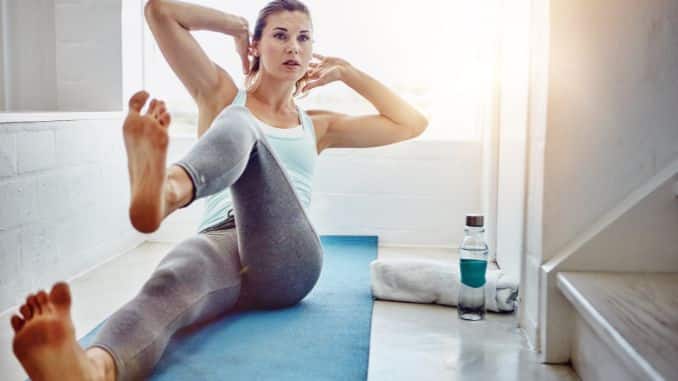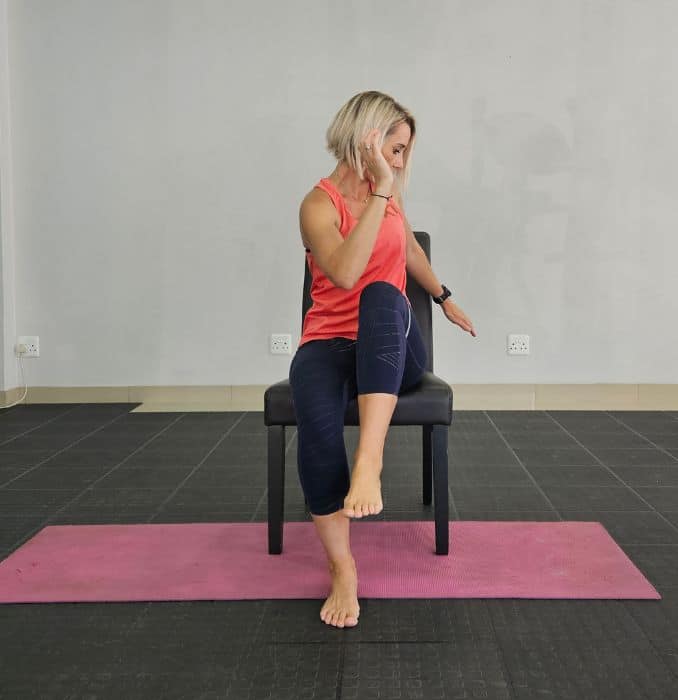Elbow exercises [¹] typically involve movements that engage the muscles in bending and straightening the elbow joint. These movements include bending the elbow (flexion) and straightening the elbow (extension).
As more athletes engage in sports [²] that involve overhead arm movements, the prevalence of elbow injuries, such as lateral epicondylitis, is increasing. This injury, affecting over half of such athletes, leads to pain where the elbow's external muscles connect to the bone.
Including exercises like elbow touches in your workout routine can be really good for your arms. Additionally, Elbow touches help make your core stronger, make you more flexible, and help you stand up straighter by moving your body in different ways. Doing this exercise regularly can make your core muscles stronger, reduce the chance of hurting your back, and help you balance better. It's especially important for athletes who want to keep their arms strong and their bodies tough.
Target Muscles of Elbow Touches Exercise

- Core muscles: The abdominal muscles, including the rectus abdominis, obliques, and transverse abdominis, are engaged to stabilize the torso and control the movement of the arms during elbow touches.
- Arm muscles: The muscles of the arms, including the biceps and triceps, are activated as they support the movement of the arms during elbow touches.
- Shoulder muscles: The deltoid muscles, located in the shoulders, assist in stabilizing and controlling the movement of the arms during elbow touches.
Transformative Effects of Elbow Touch Workouts
Elbow exercises strengthen and stabilize the muscles around the elbow joint. This is crucial for both daily activities and athletic movements. Strengthening these muscles can contribute to injury prevention and rehabilitation conditions such as tennis elbow or golfer's elbow, which are forms of tendonitis.
1. Core Strengthening

Elbow touches engage the abdominal muscles efficiently, boosting overall core strength. A strong core is necessary for balance, stability, and injury prevention.
2. Improved Spinal Flexibility
The dynamic rotation of elbow touches improves spinal flexibility. This greater range of motion adds to better posture and less back discomfort.
3. Enhanced Coordination
Touching the opposing elbow demands the synchronization of several muscle groups. This enhances not only motor abilities but also whole-body coordination.
4. Postural Support

Engaging the transversus abdominis and obliques aids in maintaining good posture. This is especially advantageous for people who sit for long periods, as it lowers the risk of developing postural disorders. Incorporate dynamic stretches to work with your posture and breathing.
5. Functional Fitness
The workout resembles normal body movements; it is extremely adaptable to regular activities. The improved core strength and flexibility translate into better performance in everyday chores.
6. Reduced Back Pain Risk

Strengthening the core muscles, particularly the transversus abdominis, gives greater spine support. This can help to relieve and prevent lower back pain by increasing spinal stability. For patients experiencing lower back pain [³], core stability exercises proved more effective in reducing pain and improving back-specific functional status compared to general exercise in the short term. And elbow touches are considered a core stability exercise.
7. Time-Efficient Exercise
Elbow touches are a simple yet effective exercise that can be done without any specialized equipment. This simplicity makes them feasible for individuals with hectic schedules or restricted gym accessibility.
8. Caloric Burn
The dynamic nature of elbow touches raises the heart rate, contributing to calorie burn. This makes the activity excellent for anyone aiming to shed pounds or enhance their cardiovascular fitness.
How to Perform Elbow Touches Exercise Correctly
Elbow Touches
Lie on your back with your legs extended in front of your body. Place your hands by your ears or interlace your fingers behind your head. Contract your core. Lift both legs off the ground, then crunch your upper body forward, twisting your upper body to one side as you bring one knee to touch your opposite elbow. Hold the position for several deep belly breaths, in through your nose, out through your mouth. Return to the starting position and repeat the movement on the opposite side.

Note: To make this exercise easier, you can bring one elbow towards the same side of your leg while simultaneously extending your other leg straight, aiming to touch your elbow to your knee.
Variations and Modifications of Elbow Touches Exercise
1. Straight Leg Elbow Touches
Lie on your back on the floor with your knees bent and feet flat on the floor. Place your hands by your ears or interlace your fingers behind your head. Extend both legs up towards the ceiling. Engage your core and crunch your upper body forward, twisting your upper body to one side as you bring your elbow to touch your knee. Return to the starting position and repeat the movement on the opposite side.
 |
 |
2. Seated Elbow Touches
Begin in an upright sitting position on the edge of a chair with your knees bent and feet flat on the floor, maintaining good alignment in your upper body. Engage your core. Twist your upper body to one side as you drive one knee towards the opposite elbow. Return to the starting position and repeat the movement on the opposite side.
 |
 |
3. Crossed-Leg Elbow Touches
Lie on your back on the floor with your knees bent and feet flat on the floor.
Lie on your back with your knees bent and your feet flat on the floor. Cross your right leg by the ankle over your opposite knee. Place one hand by your ear as you rest your opposite arm on your side. Engage your core and crunch your upper body forward, twisting your upper body to one side as you bring one elbow to touch the opposite knee. Return to the starting position and repeat the movement on the opposite side.
 |
 |
Common Mistakes to Avoid While Doing Elbow Touches

- Neck Strain: Instead of relying on neck muscles, engage the core to initiate rotation and avoid unneeded neck strain.
- Overextension of the Head and Shoulders: Maintain a regulated lift and avoid excessive elevation to protect spinal alignment and avoid pressure on the neck and lower back.
- Rushing through the Exercise: Prioritize maintaining proper form, especially when in a plank position, over speed to ensure that each movement is intentional, maximizing the exercise's benefits for physical fitness.
- Improper Breathing: Remember to exhale during the rotation and inhale when returning to the beginning position, as failing to do so can negatively impact performance and efficacy. Breathing is an important component to incorporate into your fitness journey.
Conclusion: The Final Twist

In simple terms, Elbow Touches are a fun exercise that strengthens your tummy and back muscles, making your entire body stronger. By incorporating this workout into your routine, you engage multiple muscle groups, including the important side muscles called oblique muscles. It's like doing different moves that work your core and improve your overall body strength and flexibility.
Beginners should do the exercises correctly to avoid injuries. As they get better, they can add more challenging variations to strengthen different muscles. Elbow Touches contribute to a stronger middle, better posture, and overall well-being.
Are you tired of living with the discomfort of tennis elbow? Our Tennis Elbow Pain Solution could be just what you need to find relief! Check it out now and take the first step towards a pain-free life.





